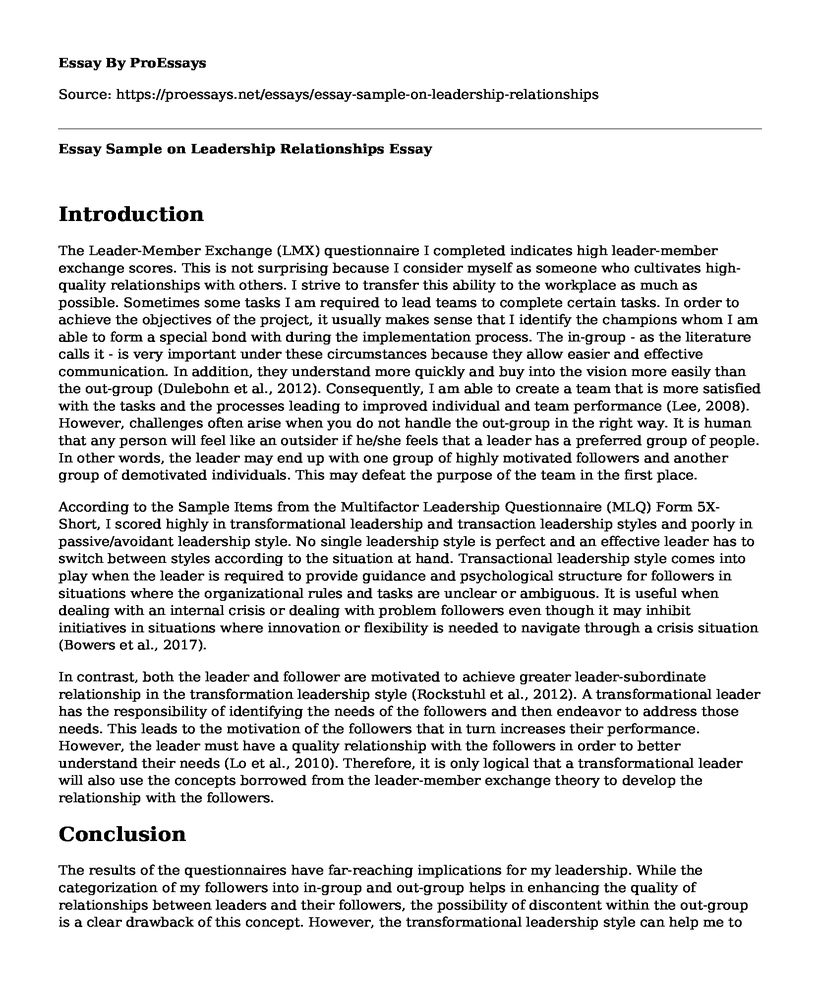Introduction
The Leader-Member Exchange (LMX) questionnaire I completed indicates high leader-member exchange scores. This is not surprising because I consider myself as someone who cultivates high-quality relationships with others. I strive to transfer this ability to the workplace as much as possible. Sometimes some tasks I am required to lead teams to complete certain tasks. In order to achieve the objectives of the project, it usually makes sense that I identify the champions whom I am able to form a special bond with during the implementation process. The in-group - as the literature calls it - is very important under these circumstances because they allow easier and effective communication. In addition, they understand more quickly and buy into the vision more easily than the out-group (Dulebohn et al., 2012). Consequently, I am able to create a team that is more satisfied with the tasks and the processes leading to improved individual and team performance (Lee, 2008). However, challenges often arise when you do not handle the out-group in the right way. It is human that any person will feel like an outsider if he/she feels that a leader has a preferred group of people. In other words, the leader may end up with one group of highly motivated followers and another group of demotivated individuals. This may defeat the purpose of the team in the first place.
According to the Sample Items from the Multifactor Leadership Questionnaire (MLQ) Form 5X-Short, I scored highly in transformational leadership and transaction leadership styles and poorly in passive/avoidant leadership style. No single leadership style is perfect and an effective leader has to switch between styles according to the situation at hand. Transactional leadership style comes into play when the leader is required to provide guidance and psychological structure for followers in situations where the organizational rules and tasks are unclear or ambiguous. It is useful when dealing with an internal crisis or dealing with problem followers even though it may inhibit initiatives in situations where innovation or flexibility is needed to navigate through a crisis situation (Bowers et al., 2017).
In contrast, both the leader and follower are motivated to achieve greater leader-subordinate relationship in the transformation leadership style (Rockstuhl et al., 2012). A transformational leader has the responsibility of identifying the needs of the followers and then endeavor to address those needs. This leads to the motivation of the followers that in turn increases their performance. However, the leader must have a quality relationship with the followers in order to better understand their needs (Lo et al., 2010). Therefore, it is only logical that a transformational leader will also use the concepts borrowed from the leader-member exchange theory to develop the relationship with the followers.
Conclusion
The results of the questionnaires have far-reaching implications for my leadership. While the categorization of my followers into in-group and out-group helps in enhancing the quality of relationships between leaders and their followers, the possibility of discontent within the out-group is a clear drawback of this concept. However, the transformational leadership style can help me to overcome the challenges of an out-group by being holistic about the emotional/ human needs of all the team members (Asgari et al., 2008). Communication, which is at the center of leader-follower exchange, is the key to understanding the needs of team members. I will have to use both concepts to become an effective leader.
References
Asgari, A., Silong, A. D., Ahmad, A., & Samah, B. A. (2008). The relationship between transformational leadership behaviors, organizational justice, leader-member exchange, perceived organizational support, trust in management and organizational citizenship behaviors. European Journal of Scientific Research, 23(2), 227-242.
Bowers, M. R., Hall, J. R., & Srinivasan, M. M. (2017). Organizational culture and leadership style: The missing combination for selecting the right leader for effective crisis management. Business Horizons, 60(4), 551-563.
Dulebohn, J. H., Bommer, W. H., Liden, R. C., Brouer, R. L., & Ferris, G. R. (2012). A meta-analysis of antecedents and consequences of leader-member exchange: Integrating the past with an eye toward the future. Journal of management, 38(6), 1715-1759.
Lee, J. (2008). Effects of leadership and leader-member exchange on innovativeness. Journal of managerial psychology, 23(6), 670-687.
Lo, M. C., Ramayah, T., Min, H. W., & Songan, P. (2010). The relationship between leadership styles and organizational commitment in Malaysia: role of leader-member exchange. Asia Pacific business review, 16(1-2), 79-103.
Rockstuhl, T., Dulebohn, J. H., Ang, S., & Shore, L. M. (2012). Leader-member exchange (LMX) and culture: A meta-analysis of correlates of LMX across 23 countries. Journal of Applied Psychology, 97(6), 1097.
Cite this page
Essay Sample on Leadership Relationships. (2022, Jul 25). Retrieved from https://proessays.net/essays/essay-sample-on-leadership-relationships
If you are the original author of this essay and no longer wish to have it published on the ProEssays website, please click below to request its removal:
- Customers in Co-Creation of Products and Services
- Research Paper Example on Project Management
- PM Leadership Essay
- Organizational Culture - Term Paper
- General Electric Company Case Study Paper Example
- Essay on COBIT: Bridging the Gap Between Technical Matters, Business Risks and Control Requirements
- Addressing Substance Abuse in Schools: Challenges, Interventions, and Comprehensive Policies - Free Report







